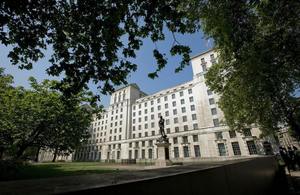Science and Technology showcased for the Army
The Defence Science and Technology Laboratory (Dstl) demonstrated its land environment Science and Technology (S&T) capability to Army Headquarters in a one-day showcase on Monday 1 October.

At the event in Andover, Dstl S&T specialists, supported by industry partners, highlighted the role of Dstl and displayed a variety of kit and capabilities.
While Dstl has been supporting front line commands for many years, embedded S&T posts have now been established within Army HQ which will have a much stronger role in the delivery of military capability in the future.
Senior Science Gateway Mike Green said:
My role is all about understanding the Army’s S&T needs, now and in the future, and providing technical advice and support.
With that understanding, I can reach out across the wider S&T community within government or across industry and academia to anticipate, plan and implement the Army’s requirements.
Dstl will also be able to call on support from S&T teams within other front line commands and Defence Equipment and Support to ensure a coherent and focused research programme.
Among the items on display at Army HQ were a prototype Scout specialist vehicle, pelvic protection, future helmets and body armour, and a portable respirator kit. Scientists and military advisers were on hand to answer questions about Dstl’s role in developing these programmes of work.
Recent triumphs of Army/S&T co-operation include:
•** Foxhound** - the S&T programme behind Foxhound provided the latest armour research, state-of-the-art technology from the motorsport industry, and rigorous blast trials to validate its survivability based on in-theatre and future threats. The whole process from initial concept to production took just 36 months, with close working between Dstl, the Armed Forces and industry.
•** Boomerang** - troops in Afghanistan are using the state-of-the-art acoustic shot-detection system ‘Boomerang 3’ to protect against small arms fire. Dstl conducted extensive trials with the Infantry Trials and Development Unit and in theatre. Boomerang 3 was identified as the preferred system, and Dstl then worked with Maxord Ballistics Ltd to improve the system.
•** Multi-Terrain Pattern -** Dstl scientists researched and tested the multi-terrain camouflage clothing that led to the first change in Army uniform in more than 40 years. Working with Army personnel, tests were conducted to see which camouflage would work the best in different environments - assessing texture, tones of patterns and colour. Computer-modelling was carried out across representations of green zone, desert and transition backgrounds and multi-terrain camouflage was proven to improve mission effectiveness.
The work by Dstl scientists is welcomed by the Army, as Major General Bruce Brealey explains:
It is already very clear that the Dstl S&T Gateway is a fundamental core element of the Army’s capability management organisation.